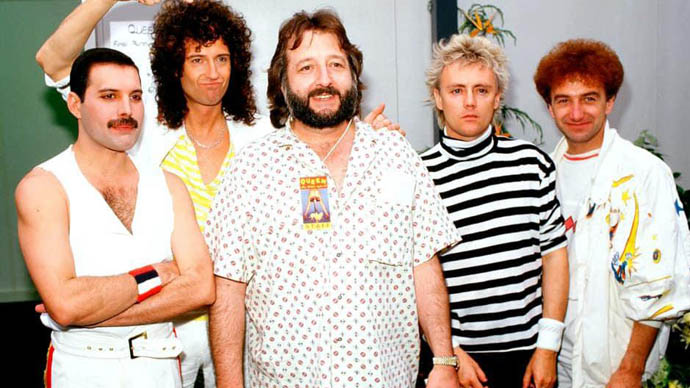OBITUARY
Gerry Stickells obituary
Unflappable road manager known as ‘Mr Grumpy’ who masterminded Queen’s tours after starting out as driver for Jimi Hendrix
17 April 17 2019

Gerry Stickells, centre, with Queen in 1986 Gerry Stickells, centre, with Queen in 1986The first time Gerry Stickells organised a gig overseas, as Jimi Hendrix’s road manager, he took all of the band’s equipment with him on a train from London to Munich. The guitarist was playing a residency at the city’s Big Apple club. “I got the help of a railway porter when we arrived,” Stickells said.
By the time he was doing a similar job for Queen in the 1980s, he was in charge of a vast logistical operation that included half a dozen 44ft trailers, two buses, a private aircraft for the band, a crew of 22 technicians and enough lighting and sound equipment to “suck up several million watts”.
In the intervening years Stickells had emerged not only as rock’s top production manager, but also acted as midwife to the birth of the lavish, multimillion-pound modern touring industry.
Bearded and burly, he was sometimes known as “Uncle Grumpy”, but little fazed him and his reputation as a fixer was unrivalled. “He knew how to handle every situation,” said Chris Lamb, his business partner with whom he formed GLS Productions.
By the time he had organised the staffing, travel, trucking, ticketing, lighting and stage rigging for a large tour — his clients included Elton John, Paul McCartney, Abba, Fleetwood Mac and Madonna — he was more like a lord mayor than a road manager, in charge of moving the equivalent of a small town across continents. He took the daunting logistics of the task in his stride. “It was a day-to-day struggle,” he conceded, “but I don’t think the logistical problems are what makes this work hard. It’s your job to deal with them. The hardest thing is dealing with the personalities involved.”
Yet he managed that with aplomb, too. Peter Hince, who spent a decade working for him as a member of Queen’s road crew, told The New York Times that his boss was the only one who could deal with Freddie Mercury when the singer “chose to be difficult and play the diva”.
With characteristic diplomacy Stickells merely noted that “once you become used to artists’ moods, you can stay a step ahead”. Roger Taylor, Queen’s drummer, described him as a “father figure, great friend and teacher, and an island of calm in the midst of chaos”.
Stickells became famous for organising elaborate shows in huge stadiums and his final gig was as a consultant for the Rolling Stones when they played for about 1.5 million people on Copacabana beach, Rio de Janeiro, in 2006.
Gerald Richard Stickells was born in 1942, in Lydd, Kent. His parents, Thomas and Doris (née Coleman), were farm labourers, making a precarious living herding sheep on Romney Marsh. He was one of their ten children.
By the age of 15 he had become an apprentice mechanic in a garage in New Romney, cycling eight miles there and back every day. By his own account he was one of life’s “drifters” when he met Hendrix’s manager Chas Chandler in 1966. The unknown guitarist, who had just arrived in London from America, was about to release his first single, Hey Joe, and Stickells was offered a job as his driver and general factotum on £20 per week (about £400 today).
Driving Hendrix and his band the Experience around in a Ford Thames van, Stickells swiftly became the model of the indispensable roadie. When Hendrix smashed his guitar or set fire to it on stage, it was Stickells who repaired the instrument for the next night’s gig. “The body was in several pieces, so I nailed it together. It was hardly noticeable from the front,” he said. The next night the instrument would be smashed again and Stickells would be required to perform another hammer and nails job.
Another impressive trick involved running on stage when Hendrix broke a guitar string. “He continued to play and he held the guitar up so that I could put on a new string. He tuned it without stopping the song.”
On Hendrix’s first American tour, Stickells drove the band and their equipment around the country in a station wagon. “Planning was non- existent. I remember we came to one gig and found that it had been cancelled a week before,” he recalled.

That soon changed and by 1969 Hendrix was playing at huge rock festivals. Stickells was on hand to organise the helicopters in and out of Woodstock, where the guitarist played his famously distorted version of The Star-Spangled Banner — and at a festival in Denver, when he had to rescue the band in a hired truck after a riot broke out and the police responded by filling the stadium with tear gas.
When Hendrix died in London in September 1970, Stickells was one of the first on the scene and was asked by the police to identify the body. Eleven days later it fell to Stickells to accompany Hendrix’s coffin on the 14-hour flight to Seattle for burial.
He remained in America to manage Electric Lady Studios, which Hendrix had opened in New York. Stickells later moved to Los Angeles, where he married his American wife, Sylvia (née Reed), who worked with him as a production manager and survives him.
His fondest memories were not of the stadium years with Queen, but of his early days with Hendrix when rock’n’roll meant sweaty pub and club gigs in front of a few hundred people. “When you are closer to the audience,” he said, “they become much more involved, it all feels more alive.”
Gerry Stickells, road manager, was born on July 22, 1942. He died from a brain tumour on March 6, 2019, aged 76